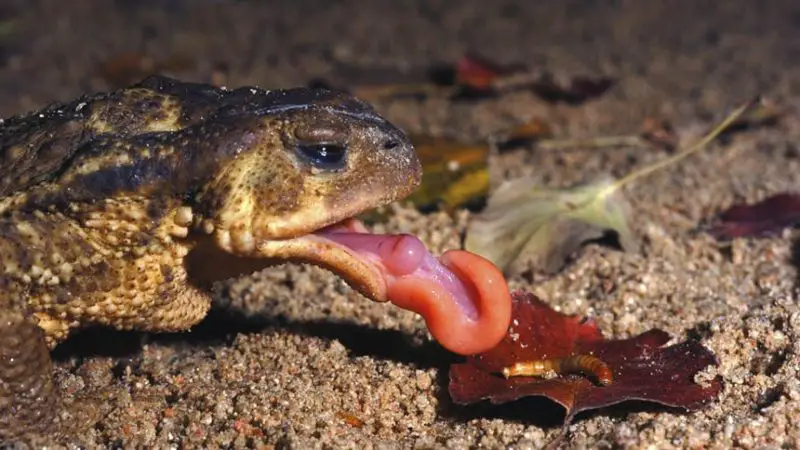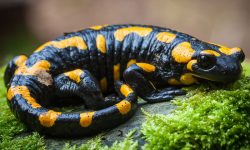Toads are hardy amphibians that thrive in forests, grasslands, marshes, deserts and even suburban yards. Their dry, bumpy skin, stout bodies and calm behavior often make them seem simple, but their feeding habits reveal a surprisingly complex and efficient lifestyle. Understanding what toads eat helps explain how they control insect populations, survive harsh climates and maintain strong health year-round.
Toads are carnivores that depend entirely on animal prey. Their diet varies by species, habitat and season, but one thing remains constant—they are opportunistic feeders that consume almost anything small enough to swallow. Equipped with fast tongues, sharp reflexes and nighttime hunting habits, toads quietly eliminate thousands of insects and invertebrates, serving as vital pest controllers.
This guide explores 20 foods toads consume in the wild, offering a closer look at how these capable predators find food, hunt effectively and support the ecosystems they inhabit.
Understanding the Toad Diet

Toads survive on a strictly animal-based diet, eating live prey that moves. Their feeding strategy is built around stealth and speed. Toads sit patiently in shaded areas or near water sources, waiting for prey to crawl or fly past. When something moves within range, they flick their long sticky tongues out in a split-second strike.
Their diet changes with size and age. Tadpoles often eat algae and detritus, but once they transform into juvenile toads, they switch completely to insects and small animals. With each growth stage, they pursue larger prey, gradually expanding their menu.
Because toads help regulate insect populations, they play a major ecological role. Healthy toad populations signal balanced ecosystems, clean water sources and abundant invertebrates—conditions that benefit countless species.
20 Foods Toads Consume in the Wild
1. Ants
Ants are among the most common foods toads eat. They live in large colonies and move constantly, creating ideal opportunities for toads to strike. Their small size makes them accessible even for young toads.
Toads wait along ant trails, using eyesight and vibration cues to detect movement. Once ants come close, quick tongue flicks allow toads to capture several within seconds. This makes ants reliable daily food sources during warm months.
Although ants provide modest protein individually, the sheer number available ensures a steady supply of nutrition for toads in most habitats.
2. Beetles
Beetles appear in nearly every environment where toads live. Their thick exoskeletons may seem protective, but toads swallow them whole without difficulty. Many toad species rely heavily on beetles throughout the year.
Toads detect beetles by listening for their movements along soil and leaf litter. Their tongues adhere strongly to the beetle’s body, preventing escape even when the beetle fights back with legs or mandibles.
Beetles offer high protein and essential fats, making them an important source of energy for adult toads maintaining territory or preparing for winter.
3. Beetle Larvae
Beetle larvae live underground or inside decaying logs, making them nutrient-rich prey for foraging toads. Their soft bodies make them easier to digest than adult beetles.
Toads locate larvae by burrowing slightly into loose soil or investigating rotting wood. Their sensitive tongues and strong feeding reflexes allow them to pull larvae out quickly before the prey retreats.
These larvae provide moisture, protein and essential nutrients that support growth, especially in young or recovering toads.
4. Worms
Earthworms are a favored food for many toad species because of their high moisture content and soft texture. Toads easily swallow worms whole despite their length.
Toads often hunt worms at night or after rainstorms when worms come to the surface. Their keen sense of movement helps them locate worms even when visibility is low. With steady bites, they pull worms from soil or leaf litter.
Worms provide hydration and dense nutrients that help toads survive dry spells or extended activity periods.
5. Slugs
Slugs thrive in damp environments, making them abundant prey for toads. Their slow movement and soft bodies make them easy to capture.
Toads follow slime trails or detect slugs visually in shaded, moist conditions. Despite their mucous coating, slugs are eaten readily and swallowed without trouble.
Slugs offer moisture and nutrients that help toads during warm nights or after long periods of dry weather.
6. Crickets
Crickets form a significant portion of the wild toad diet, especially for larger species. Their chirping and movement patterns make them easy targets at night.
Toads approach crickets slowly, relying on sound and motion sensing before striking. Once caught, crickets offer high protein and energy that support active behaviors like mating and territorial calls.
Crickets remain common across grasslands, forests and even urban areas, making them reliable prey across seasons.
7. Grasshoppers
Grasshoppers are larger prey that provide substantial nutrition. Toads usually target young or small grasshoppers that are slow enough to catch.
Toads hunt grasshoppers in open fields or meadows, using bursts of speed to close distance. Once caught, grasshoppers supply valuable protein and calories.
This prey becomes especially important in late summer when insect populations peak.
8. Moths
Moths are abundant nighttime insects that toads catch during their active periods. Their slow flight near ground level makes capture easier for toads.
Toads position themselves beneath lights, tree canopies or along paths where moths flutter low. When a moth lands or hovers within reach, toads strike swiftly.
Moths provide hydration and moderate protein, supplementing diets during peak insect seasons.
9. Flies
Flies appear in countless habitats and are easily captured by toads waiting near water sources, decaying vegetation or lighted areas.
Toads hunt flies by tracking their movement patterns and reacting to sudden landings. Their sticky tongues allow them to snatch flies mid-hop or from resting surfaces.
Flies offer a quick, easy food source for both juvenile and adult toads.
10. Spiders
Spiders form a surprising part of the toad diet. Their movements attract toads, and even web-building species become prey when they descend to the ground.
Toads approach spiders carefully and strike when they move. Despite having venom or hairs, most spiders pose no threat to toads and are swallowed easily.
Spiders provide nutrient-rich meals that support active or breeding toads.
11. Caterpillars
Caterpillars are soft-bodied prey that deliver high moisture and nutrients. Toads find them on low vegetation, fallen leaves and shrub edges.
Many caterpillars move slowly, making them easy for toads to catch. Their size makes them substantial meals for younger toads that struggle with harder prey.
During spring and early summer, caterpillars become especially abundant, giving toads a seasonal feeding advantage.
12. Millipedes
Toads sometimes eat small millipedes found under logs, rocks and moist soil. Although millipedes secrete defensive chemicals, many toad species tolerate them in small amounts.
Toads use their quick strikes to capture millipedes before the prey coils defensively. By swallowing them rapidly, toads avoid prolonged exposure to secretions.
Millipedes provide minerals and moderate nutrition, serving as supplementary food when soft-bodied insects are scarce.
13. Centipedes (Small)
Small centipedes, though fast, become prey when they wander across toad hunting grounds at night. Toads rely on rapid tongue strikes to immobilize them before they escape.
Centipedes contain high protein and essential fats but must be eaten cautiously due to their defensive bites. Most wild toads instinctively avoid large or venomous species.
These meals offer strong nutritional benefits for larger or more experienced toads.
14. Snails
Toads eat small snails by picking them up and swallowing them whole. Their digestive acids help dissolve thin shells, giving toads access to the soft interior.
Snails are common in moist garden patches, forest understories and marsh edges where toads often hunt. The calcium in snail shells also supports bone and muscle development.
Snails become especially important during rain-heavy seasons.
15. Small Frogs (Occasionally)
Some larger toad species may consume tiny frogs when food is scarce or when prey populations overlap. This behavior remains uncommon but does occur in competitive environments.
Toads rely on ambush tactics, striking when froglets move past them near water edges. The prey is swallowed quickly to prevent escape.
This opportunistic feeding highlights the flexibility of toad diets in the wild.
16. Tadpoles (Rarely)
Juvenile toads or certain species may feed on tadpoles, particularly those of other amphibians. Tadpoles offer soft, nutrient-rich meals in shallow pools.
Toads catch tadpoles by waiting near water shallows where they congregate. Quick tongue strikes allow efficient capture without entering deeper water.
These feeding events occur mainly in early spring when tadpole populations are highest.
17. Small Fish (Rare Cases)
While uncommon, some toads may consume tiny fish in shallow ponds. This happens mostly when fish are slow, trapped or weakened.
Toads strike using rapid head movements rather than tongue flicks, grabbing the fish before it swims away. Digestive enzymes then break down the meal quickly.
These nutrient-dense prey items are situational but valuable when available.
18. Soft-Bodied Larvae
Larvae of flies, beetles and moths are abundant along moist soil and vegetation. Their soft bodies make them easy for toads of all ages to consume.
Toads locate larvae by rooting lightly through leaf litter or sensing small soil vibrations. Larvae offer hydration and concentrated nutrients ideal for growth periods.
During rainy seasons, larvae can become a primary food source.
19. Termites
Termites form large colonies that provide rich, easily accessible protein for toads. Toads forage near rotting logs, stumps or underground chambers where termites emerge.
Their rapid movement attracts toads, which strike repeatedly to capture multiple termites in quick succession. This makes termites efficient group-feeding opportunities.
Termites supply energy-dense meals that help toads replenish quickly after winter.
20. Crustaceans (Tiny Land or Water Species)
Some toads, particularly those near wetlands, eat small crustaceans like isopods, amphipods or tiny freshwater shrimp. These prey offer minerals and high-quality proteins.
Toads find crustaceans by exploring shallow water edges or flipping over leaf litter where moisture remains. These animals move slowly enough for easy capture.
Crustaceans supplement toad diets during seasons when insects decrease in number.
FAQs About What Do Toads Eat
Do toads eat plants?
No. Adult toads are strict carnivores that only eat moving prey.
What do baby toads eat?
Tiny insects, springtails, mites and other micro-invertebrates.
Do toads eat mosquitoes?
Yes, they eat adult mosquitoes and larvae when available.
Do toads eat worms?
Absolutely—worms are among their favorite soft-bodied foods.
Do toads help control pests?
Yes. A single toad can eat thousands of insects each season.
Do toads eat spiders?
Yes. Spiders are common prey in gardens and forests.
Do toads eat slugs and snails?
Yes, especially in moist habitats where these animals thrive.
Do toads eat dead insects?
No. They only respond to live moving prey.
Do toads hunt during the day?
Most species hunt at night when conditions are cooler and prey is active.
Do toads eat ants?
Yes. Ants form a major part of the diet for young toads.
Final Thoughts
Toads are efficient predators that help maintain healthy ecosystems by consuming insects, worms, larvae, spiders and many other small animals. Their diet shifts naturally with the seasons, supporting growth, reproduction and long-term survival. Understanding what toads eat highlights their importance as natural pest control and reveals how adaptable they are across forests, wetlands, grasslands and gardens. These humble amphibians contribute significantly to ecological balance through their diverse and active feeding habits.






